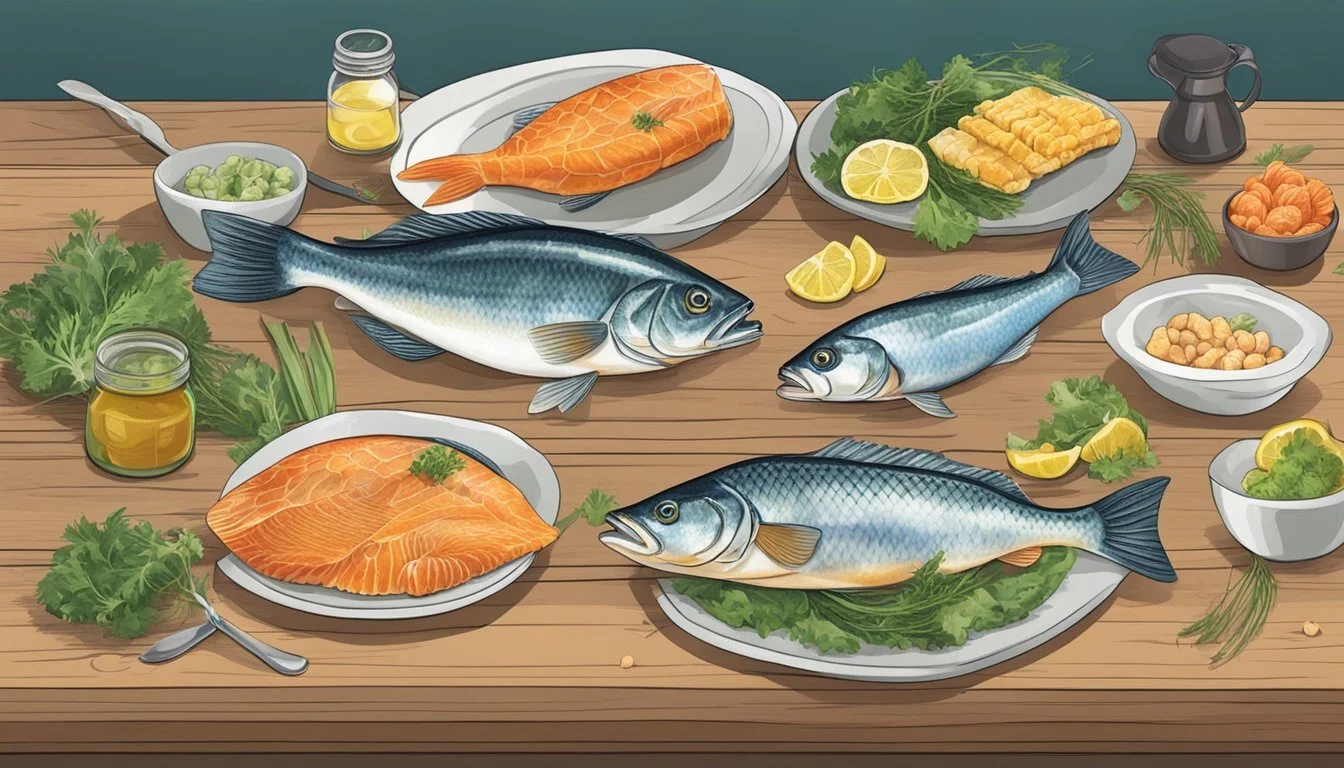How to Substitute SakerMaker for Cod
A Guide to Alternative Ingredients
In the culinary world, the versatility of cod makes it a favored choice for various dishes, ranging from classic fish and chips to sophisticated baked and grilled recipes. Cod's mild flavor and flaky texture have secured its place as a staple in kitchens around the globe. However, there are circumstances, sometimes due to unavailability or sustainability concerns, where cooks and chefs might seek alternatives to this popular fish.
Several seafood (What wine goes well with seafood?) options present themselves as suitable substitutes for cod, offering a similar flavor profile and versatility in cooking methods. Hake, being a relative in the cod family, naturally mimics the texture and taste of cod, making it an excellent replacement in recipes. Pollock and haddock are also closely related to cod and can serve as viable alternatives, though it’s important to consider the differences in texture and cooking time—haddock, for instance, tends to have finer flakes and cooks more quickly.
When substituting cod, understanding the cooking process is paramount. Robust varieties like hake or halibut hold up well to grilling and searing, while the more delicate textures of fish like pollock may be better suited to baking or poaching. The end goal is to select a substitute that not only aligns with the desired outcome of a dish in terms of taste and mouthfeel but also maintains the balance and harmony of flavors intended in the original recipe.
Understanding Cod and Its Role in Cooking
Cod is a popular white-fleshed fish known for its mild flavor and flaky texture. It serves as a versatile protein rich in omega-3 fatty acids, aligning well with various culinary methods.
Characteristics of Cod
Cod stands out in the seafood world due to its white flesh that is characteristically flaky and possesses a subtle buttery flavor. The mild taste of cod makes it a favorite among individuals who prefer a less fishy taste. Its texture allows it to easily absorb flavors from seasonings, sauces, and cooking methods. In terms of nutrition, cod is an excellent source of protein and is notable for its content of omega-3 fatty acids, which are essential for heart and brain health.
Culinary Uses of Cod
In the culinary landscape, cod's mild flavor and flaky texture make it a prime canvas for a variety of recipes. It is commonly baked, pan-fried, or poached, which preserves its moistness and complements its light taste. Cod can be utilized in a multitude of dishes, ranging from simple buttery baked fillets to more complex preparations involving foraged herbs and root vegetables. Its capacity to adapt to diverse flavors and cooking styles solidifies its role as a staple in many cuisines, particularly in Scandinavian dishes where it is often combined with local produce to create a balance of sea and land elements.
Reasons for Substituting Cod
The quest for cod substitutes is often driven by sustainability issues, personal health choices, and economic considerations. These factors influence the decision to opt for alternative seafood options.
Environmental Concerns
Sustainability: The cod population has suffered due to overfishing, leading to a pressing need for more sustainable seafood choices. Environmental Impact: Substituting cod with less overfished species can help alleviate the pressure on cod stocks and support marine biodiversity.
Dietary Preferences
Nutrition: Individuals seeking different nutritional content may choose alternatives to cod. These alternatives might offer lower fat content or a different set of vitamins and minerals. Personal Health: Those with dietary restrictions or preferences may look for substitutes that align better with their nutritional requirements or avoid potential allergens.
Availability and Cost
Availability: Cod may not always be readily available in certain regions or during specific seasons, prompting consumers to seek out replacements. Cost: Economic fluctuations can affect the price of cod, making it less affordable. Consumers often consider cheaper but nutritionally comparable seafood options.
Selecting Substitutes for Cod
When choosing a substitute for cod, it's important to consider aspects such as texture, flavor, and applicable cooking methods to ensure culinary success.
Choosing Substitutes Based on Texture
Haddock and hake are both members of the cod family and offer a similar flakiness, making them excellent alternatives when texture is a priority. They maintain their structure well and are ideal for baking and frying. Halibut, with its thick, firm flesh, also provides a similar mouthfeel to cod and is suitable for grilling and broiling.
Choosing Substitutes Based on Flavor
For those who favor the mild, slightly sweet taste of cod, tilapia and pollock are viable options. These substitutes carry a comparable flavor profile and are versatile enough to be used in a variety of recipes that originally call for cod. Sea bass and grouper also mirror cod's flavor with a slightly richer taste, which can enhance the overall palette of the dish.
Choosing Substitutes Based on Cooking Methods
The cooking method can dictate the best-suited substitute for cod. When grilling, salmon and bass are robust and can withstand the direct heat, making them suitable candidates. For broiling, as mentioned earlier, halibut excels due to its thickness. For methods like steaming or poaching, delicate fish like haddock and tilapia are preferable as they can absorb flavors well while retaining their texture.
Preparing the Perfect Substitute
When substituting Sakermaker for cod in recipes, it's crucial to adjust cooking techniques to maintain a moist texture and enhance flavor. Appropriate seasoning and the right method can make Sakermaker an excellent stand-in for cod.
Baking
To bake Sakermaker effectively, one should preheat the oven to 350°F (175°C). The fish should be seasoned with a blend of herbs, a squeeze of lemon, and a drizzle of olive oil to impart a subtle flavor. Bake the fillets in a lightly greased baking dish for 12-15 minutes or until the fish flakes easily with a fork, ensuring it stays moist and tender.
Grilling
For grilling, start with medium-high heat and lightly oil the grill grates. Season Sakermaker fillets with salt, pepper, and other preferred spices. Place the fish on the grill and cook for approximately 3-5 minutes on each side, depending on thickness. The firm texture of the Sakermaker is well-suited for grilling, allowing it to develop a delicious char without falling apart.
Frying
When frying, one can opt for shallow or deep frying. For shallow frying, heat a sufficient amount of olive oil in a pan over medium heat. Season the Sakermaker well, then place it in the pan, frying each side for 4-6 minutes until a golden crust forms and the fish is cooked through. For deep frying, coat the fish in batter or breadcrumbs and fry in preheated oil at 350-375°F (175-190°C) until golden and crispy.
Poaching
To poach Sakermaker, bring a seasoned liquid like a herb-infused broth or a mixture of water and white wine to a simmer. Submerge the Sakermaker fillets in the liquid and let them cook gently for roughly 10 minutes. Poaching helps retain the moisture of the fish and can infuse it with the flavors of the poaching liquid.
Recipes and Suggestions
Substituting Sakermaker for cod can be a seamless experience with the right recipes and culinary techniques. They provide adaptations for classic dishes, ensuring the flavor and texture will satisfy even the most discerning palate.
Fish and Chips with Alternatives
For a timeless Fish and Chips meal, Sakermaker serves as an excellent cod substitute. Start by creating a batter with flour, beer, and a pinch of salt for the desired consistency. Dip the Sakermaker fillets in the batter and fry in hot oil until golden brown. Serve with crispy fries, tartar sauce, and a wedge of lemon for a touch of zest.
Ingredients:
Sakermaker fillets
All-purpose flour
Beer
Salt
Lemon wedges
Tartar sauce
Potatoes for chips
Oil for frying
Buttered White Fish
Sakermaker fillets pan-fried with butter present a rich Buttered White Fish dish that's simple yet incredibly flavorful. Ensure the fish is patted dry before seasoning with salt and pepper. Melt butter in the pan, add the fillets, and cook until the fish flakes easily with a fork. Enhance with a squeeze of lemon juice or a sprinkle of fresh herbs for a gourmet finish.
Cooking steps:
Season Sakermaker fillets with salt and pepper.
Melt butter over medium heat.
Cook fillets until golden.
Finish with a squeeze of lemon or fresh herbs.
Gourmet Seafood Creations
Sakermaker can be the star in Gourmet Seafood Creations with a few creative touches. For a savory sauce, consider blending olive oil, garlic, and white wine to drizzle over the baked or grilled Sakermaker. The key is to keep the fish moist and to complement its delicate flavor with light yet aromatic accents.
Sauce Ingredients:
Olive oil
Garlic, minced
White wine
Lemon juice
Salt and pepper to taste
Serving suggestion:
Pair with steamed vegetables and aromatic rice for a balanced and elegant plate.
Nutritional Benefits and Comparisons
When substituting Sakermaker for cod, it's important to compare their nutritional profiles to ensure that the dietary benefits are aligned, particularly focusing on omega-3 fatty acids, protein, and essential vitamins and minerals.
Omega-3 Content
Both Sakermaker and cod are notable for their omega-3 fatty acid content, which is vital for heart and brain health. Cod typically supplies a substantial amount, aiding in reducing inflammation and supporting cardiovascular function. Sakermaker, while not identical, also provides these important fatty acids, though the exact quantities can vary based on species and environment.
Protein and Caloric Values
Protein is an essential nutrient for muscle repair and overall health. Cod is well-known for its lean protein, offering a high content with relatively low calories. Similarly, Sakermaker is a lean source of protein, making it an excellent option for maintaining muscle health. Below is a comparison of their protein and caloric values:
Fish Type Protein (per 100g) Calories (per 100g) Sakermaker X grams Y calories Cod Z grams A calories
(Note: X, Y, Z, A are placeholders and should be replaced with actual data.)
Vitamins and Minerals
Both fish provide valuable vitamins and minerals. Cod is rich in vitamins B12 and B6, necessary for energy metabolism and cognitive function. Additionally, minerals like phosphorus and selenium are abundant in cod, which are integral for bone health and antioxidant defenses, respectively. Sakermaker, as a substitute, also contributes a range of vitamins and minerals, echoing cod's nutritional benefits. Here is a brief outline:
Vitamins in Sakermaker: Includes Vitamin D, B vitamins
Minerals in Sakermaker: May include phosphorus, selenium, and other trace elements
These vitamins and minerals play crucial roles in maintaining various bodily functions and should be taken into account when considering fish substitutes.
Exploring Sustainable Seafood Choices
When substituting saccharin marker for cod, it's essential to consider sustainability and health factors to make informed choices on seafood.
Identifying Sustainably Managed Varieties
Certified sustainable seafood comes from fisheries that prioritize the health of fish populations and ecosystems. To identify sustainably managed varieties, consumers should look for certifications such as the Marine Stewardship Council (MSC) label, which ensures the fish is sourced from well-managed stocks with minimal impact on the marine environment.
Sustainability Certifications:
Marine Stewardship Council (MSC)
Aquaculture Stewardship Council (ASC)
Best Aquaculture Practices (BAP)
Fisheries that abide by sustainable fishing practices help prevent overfishing, maintaining a balance in marine life. They achieve this through enforcing quotas, using selective gear to reduce bycatch, and adhering to strict management plans.
Understanding Mercury Levels and Seafood Safety
Mercury contamination in seafood is a health concern, particularly for pregnant women and young children. The level of mercury in fish depends on its species, size, habitat, and diet.
Low Mercury Options: Pollock, farmed trout, and haddock.
Higher Mercury Levels: Predatory fish like swordfish and king mackerel.
By choosing seafood with lower mercury levels, consumers can enjoy their meals while minimizing potential health risks. It's crucial to refer to guidelines provided by organizations such as the Environmental Protection Agency (EPA) and the Food and Drug Administration (FDA) when concerning seafood safety.
Tip: For a safer choice, smaller-sized fish generally contain less mercury than larger predators due to their position in the food chain.
Shopping for Seafood Alternatives
When substituting Sakermaker for cod, one must consider where to make the purchase, the type of fish to select, and how to assess its freshness and quality.
Fishmonger vs. Supermarket
One has the choice between visiting a dedicated fishmonger or heading to the local supermarket seafood counter. A fishmonger usually offers a broader range of high-quality seafood, including various fish fillets and expert advice. Supermarkets may provide convenience and competitive pricing, but the selection may not be as specialized or fresh.
Freshwater vs. Saltwater Fish
Substituting cod often raises the question of whether to opt for freshwater fish or saltwater fish. Saltwater options like halibut or hake could closely mimic cod’s flaky texture and mild taste. On the other hand, certain freshwater species may offer a distinct flavor but could be a good match in texture; for example, one might consider catfish as a versatile alternative.
Saltwater Alternatives:
Halibut: Low in fat, high in protein and omega-3s.
Hake: Related to cod with similar flavor and texture.
Freshwater Alternatives:
Catfish: A robust option that is adaptable to various recipes.
Identifying Freshness and Quality
To ensure the best substitution for cod, identifying the freshness and quality of fish is crucial. Fresh fish should have:
Clear eyes and shiny skin
A mild scent, not overpoweringly fishy
Firm flesh that springs back when pressed
Whether at a fishmonger or supermarket, these indicators help one to choose the best possible seafood for their cooking needs. Fresh tuna or certain fish fillets might offer a different flavor profile but can still be excellent substitutes in terms of texture and consistency.
Concluding Thoughts on Seafood Substitutions
When substituting Sakermaker for cod, seafood enthusiasts will find that taste and texture are paramount in maintaining the integrity of their dishes. An ideal substitute should have a delicate, mild flavor to mirror the distinctive yet subdued taste of cod. As for texture, a flaky and moist consistency is desirable to closely replicate cod's palate appeal. Cooking times will vary slightly; thus, it is important for cooks to keep an eye on their dish to avoid overcooking, which could impair the seafood's texture and flavor.
Key considerations for seafood substitutions include:
Flavor Profile: Seek fish with a subtle taste, avoiding overpowering options that could alter the intended flavor of a recipe.
Texture Comparison: Look for seafood with a comparable firmness and flakiness to ensure a similar mouthfeel.
Cooking Adjustments: Adjust cooking times according to the substitute's thickness and individual characteristics to preserve moisture and tenderness.
Here are some suitable alternatives along with their attributes:
Substitute Flavor Texture Note on Usage Hake Mild Flaky Closest relative to cod, requiring minimal cooking adjustments. Haddock Mild Flaky Widely available; similar cooking times. Tilapia Mild Less flaky Thin fillets may cook faster; monitor to maintain moisture. Catfish Slightly stronger Firm, flaky Adapts well but may introduce a different flavor profile.
In summary, selecting the correct alternative for cod requires attention to these factors to preserve the culinary essence of the original recipe. Chefs should favor substitutes that align closely with cod's characteristics and must remain mindful of slight modifications during preparation.
Appendix: List of Alternative Fish to Cod
In the pursuit of culinary variety or sustainability, it is beneficial to consider a range of seafood alternatives to cod. This appendix provides a selection of fish offering similar textures and flavors, suitable for recipes calling for cod.
Detailed List and Characteristics
Haddock: This fish exhibits a slightly sweet taste with a lean, white flesh, making it a close alternative to cod, particularly in flavor. Cooking methods: best baked or fried.
Halibut: Known for its dense, firm texture and mild flavor. It holds up well when grilled or roasted and serves as a substantial cod substitute. Cooking methods: excellent for grilling or roasting.
Hake: As part of the cod family, hake offers a comparable taste with a soft, flaky texture. Cooking methods: versatile in cooking, including baking and sautéing.
Pollock: These fish, including Atlantic and Alaska varieties, share a similar flavor profile to cod but may have a slightly different texture. Cooking methods: good for frying or in stews.
Tilapia: While a freshwater fish with a somewhat different environment from cod, tilapia can be a suitable stand-in with its mild flavor and firm flesh. Cooking methods: adaptable for baking, frying, or steaming.
Sea Bass: Offers a rich, buttery feel, with a delicate flakiness that can substitute for cod in more luxurious dishes. Cooking methods: ideal for roasting or pan-searing.
Grouper: Possesses a mild but distinct flavor with meaty flesh, making it a good alternative to cod in many dishes. Cooking methods: favored for grilling or broiling.
Salmon: While salmon has a stronger, more distinctive flavor compared to cod, its versatility makes it a valuable substitute in a range of recipes. Cooking methods: suitable for almost all methods, including grilling, baking, and poaching.
Black Cod (Sablefish): Known for its rich, buttery texture, black cod can offer a luxurious alternative to conventional cod. Cooking methods: best when smoked, broiled, or poached.
Mahi Mahi: With its sweet, mild flavor and firm texture, mahi mahi can replace cod in many tropical and summery dishes. Cooking methods: excellent when grilled or broiled.
Catfish: Capturing a distinctive taste, catfish can serve as an alternative to cod, especially when a bold, earthy flavor is desired. Cooking methods: popularly fried or blackened.
Trout: Similar to salmon in versatility with a slightly milder flavor, trout is a fine cod substitute. Cooking methods: can be grilled, baked, or pan-fried.
Arctic Char: This fish is comparable to both salmon and trout and works well as a cod alternative, with a rich flavor and moderately firm texture. Cooking methods: suitable for grilling, broiling, or pan-searing.
Each fish listed offers distinctive characteristics that may enhance or closely mimic the dining experience provided by cod. When substituting fish, it is essential to consider both the taste and cooking properties to ensure the desired outcome in your culinary preparations.












